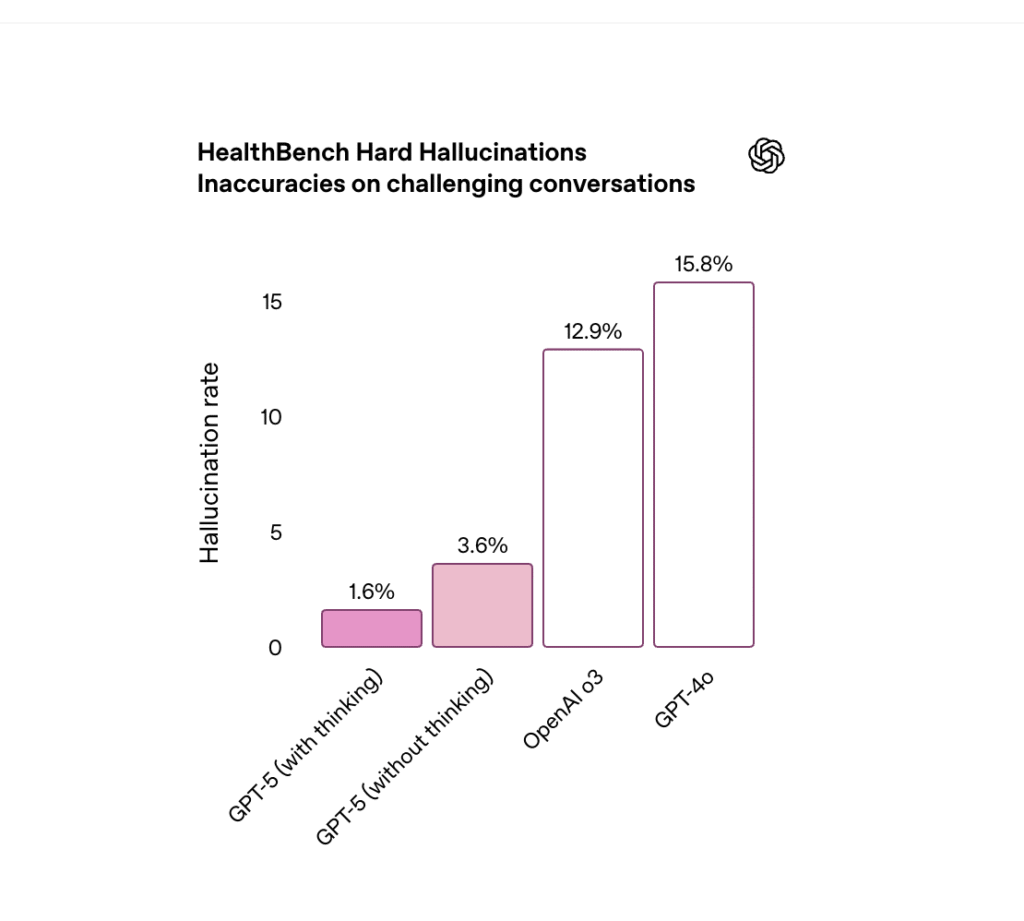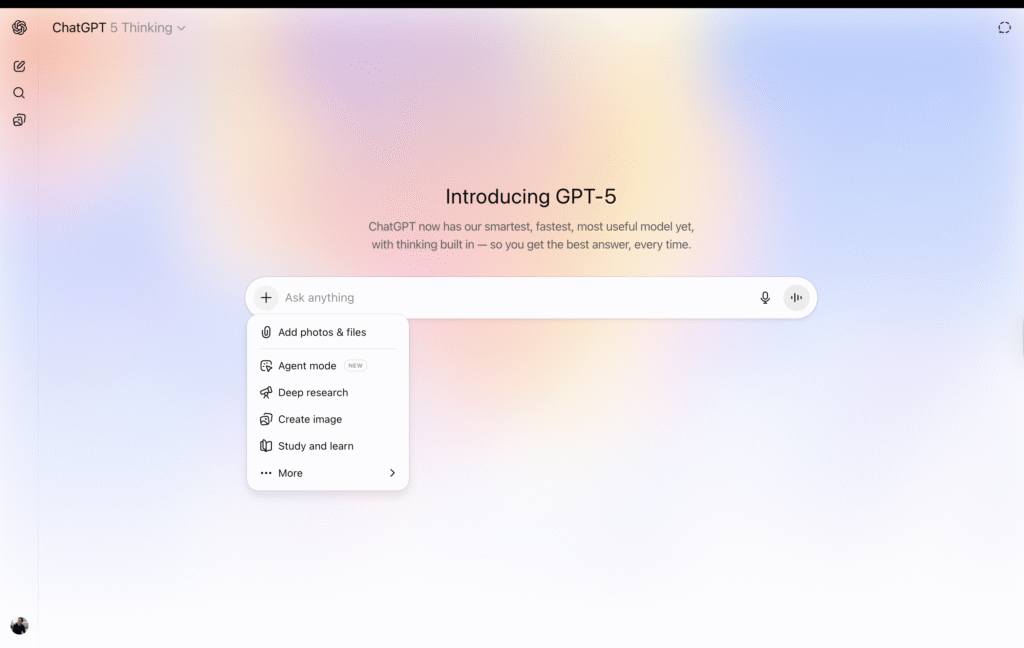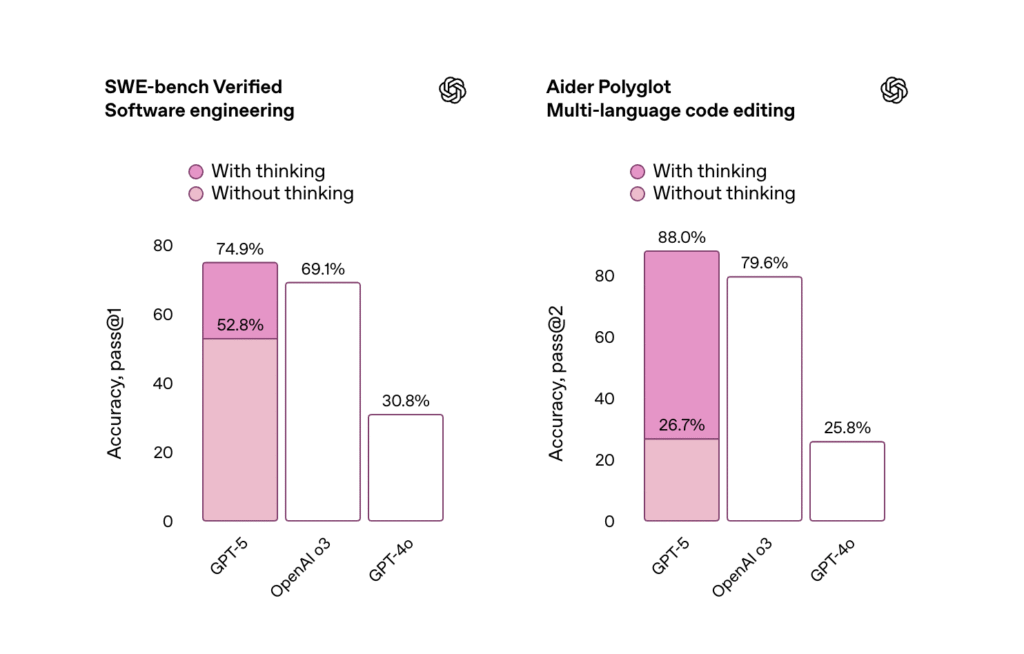OpenAI has set GPT-5 as the default model in ChatGPT, also for free accounts. You don’t have to “choose model” anymore: the system decides when to respond fast and when to “think” deeper. Result: expert level AI available to anyone (with usage limits in the free layer).
What exactly is GPT-5
It is a unified system with a fast model for most questions, a deep reasoning model (GPT-5 Thinking) for the difficult ones, and a router that chooses which model to use automatically based on your query.
From what I have been testing, by default, the system routes you to a faster response, and sometimes the quality of the output is compromised or not as expected unless you select deep reasoning. As there are certain limitations to the use of this functionality, a trick to force the model to ignore this change is to ask at the prompt, “Think about this in depth”.
OpenAI must undoubtedly evolve its routing model, which currently results in inaccurate outputs.
Is it really free?
Yes, but with nuances:
- Free: you have access to GPT-5 with usage caps; when you reach them, ChatGPT switches to GPT-5 mini until they are renewed. (OpenAI does not publish exact figures of the caps).
- Plus/Pro/Team/Enterprise: more capacity, and Pro unlocks GPT-5 Pro (extended reasoning) and very wide limits.
Note: The model selector does not disappear completely. Paid users can force GPT-5 thinking from the selector or by typing something like “think this through.”
What are the limitations of use?
- Free: limited access to GPT-5. Up to 10 messages every 5 hours; upon reaching the limit, the conversation switches to GPT-5 mini until it is renewed. Plus, 1 message/day with GPT-5 Thinking (deep reasoning).
- Plus: extended limits. Up to 160 messages every 3 hours with GPT-5 (temporary increase) and up to 200 messages/week if you manually select GPT-5 Thinking. The automatic switch to Thinking does not count against this quota.
- Pro: unlimited access to GPT-5 models (subject to policies and fair use). Includes model selector and access to advanced reasoning variants.
- Team: unlimited messages with GPT-5 (with anti-abuse guardrails) and “generous” access to GPT-5 Thinking/Pro; if you force Thinking manually, the 200/week cap applies as in Plus. Credits can be added if the team needs more use of advanced features.
- Enterprise: unlimited messages with GPT-5 (subject to terms of service and fair use); controls and limits are managed at the contract/enterprise level.
What's New That Matters (and it's not smoke)
- Fewer hallucinations: GPT-5 reduces factual errors vs. previous models (OpenAI reports large improvements vs. o3 and GPT-4o, especially in health, coding, and writing).
- Useful security, not walls: debuts “safe completions”: instead of a dry “I can’t”, it offers partial and safe answers or explains why it can’t and suggests safe ways.
- Personalities: 4 chat styles (Cynic, Robot, Listener, Nerd) to adapt the tone without complex prompting.
- Voice and multimodal: voice enhancements (expanded access in paid plans) and improved reading/understanding of images and visual content.

The new Interface
The new interface is very clean, although I was surprised to see the disappearance of all the models I had access to until now, which I used depending on the request.
This may seem a bit “strange” at first, but for not very experienced users it will greatly simplify its use, since the model is unique as mentioned above and it is the router that is responsible for redirecting the query internally.
By clicking on the “+” sign you can access the Agent Mode or activate Deep Research or other functionalities.

Programming and vibe coding
OpenAI presents GPT-5 as its best model in code and “agentic” tasks (using tools, chaining actions, etc.).
GPT-5 understands vague ideas and turns them into working prototypes (pages, mini-apps, automations). It’s like explaining to a colleague, “make me something that does X,” and that colleague gives you back something that already works. I called this vibe coding in other articles(yes, I also tested it with DeepSeek), and with GPT-5 the experience is more stable and faster for the “first draft” of software.
If you want to test this functionality, I will give you some examples:
- Marketing: “Create a landing page with form and integrate it with my Google Sheet and send me an email when you collect data”. → Returns you the page + the script.
- Sales: “Generate me a bot that sorts conversations by intent (demo, price, support) and stores them in a simple CRM”. → Usable prototype to validate.
- Data: “Clean up this Excel (names, duplicates) and create a minimal dashboard”. → Report ready for submission.

The idea is the same: describe the vibe/result and have the AI fill in the details. The difference is that with GPT-5 the first shot usually comes out more polished in interface and less fragile with real data. If you liked that experiment with DeepSeek I did some months ago, with this new model less friction to go from “demo” to “I can use it today”.
How does gît-5 compare to its competitors?
The charts currently in circulation reflect GPT-5 as the absolute leader in mathematical, programming, and reliability tasks, although “Grok 4” and Claude Opus manage to approach or surpass it in some very demanding benchmarks.
In the hallucination/error plots, GPT-5 has truly low levels and shows a very significant advance in language model accuracy.
In context window graphics, GPT-5 far outperforms the competitors of previous commercial versions.
Speed comparisons show GPT-5 responding faster and achieving lower latency than o3, although Claude and Gemini are close behind in certain tests. Be careful with this, since, as we have seen above, the “default” router uses the fast model and makes certain errors.
As far as pricing is concerned, the cost model has to do with the inputs and outputs of tokens in the model. To give you an idea, 1 token = 4 characters.
For price/quality balance, GPT-5 is a safe bet; if you need a lot of cheap volume, Gemini Flash/Flash-Lite performs better; and if you prioritize compliance and very careful writing, Claude justifies the extra.
Price Table per Million Tokens (MTok)
| Supplier | Model | Entrance | Caché* (input) | Output | Key notes |
|---|---|---|---|---|---|
| OpenAI | GPT-5 | $1.25 | $0.125 | $10.00 | Caché = ~90% discount on repeated input(OpenAI Platform) |
| OpenAI | GPT-5 mini | $0.25 | $0.025 | $2.00 | Same cache scheme(OpenAI Platform) |
| OpenAI | GPT-5 nano | $0.05 | $0.005 | $0.40 | Same cache scheme(OpenAI Platform) |
| Gemini 2.5 Pro (≤200k) | $1.25 | $0.31 | $10.00 | >200k: $2.50 / $0.625 / $15. Cache with storage cost: $4.50 per 1M tokens/h.(Google AI for Developers) | |
| Gemini 2.5 Flash | $0.30 | $0.075 | $2.50 | Implicit caching enabled by default (minimum token threshold)(Google AI for Developers) | |
| Gemini 2.5 Flash-Lite | $0.10 | $0.025 | $0.40 | Cheaper option for high volume(Google AI for Developers) | |
| Anthropic | Claude Sonnet 4 | $3.00 | Reading: $0.30 – Writing 5m: $3.75 – 1h: $6 | $15.00 | Cache separates write (expensive) and read (cheap)(Anthropic) |
| Anthropic | Claude Opus 4 | $15.00 | Read: $1.50 – Write 5m: $18.75 – 1h: $30 | $75.00 | Anthropic range stopper(Anthropic) |
* Caching makes repeated input (manuals, shared context) much cheaper.
If I have to stick with one idea, it’s this: GPT-5 is immediately useful. It puts pro-level AI in the hands of anyone, reduces skids, understands context better, and, in terms of cost, competes head-to-head with the best on the market.
It is undoubtedly a very significant incremental improvement. It is not the revolution that some of us expected, but its enormous social impact and its role in the democratization of AI are undeniable. It will be fascinating to see how this model, now available to billions, transforms our daily interactions with artificial intelligence.
What can you do with this today?
Three steps: 1) open it up and say “think this through” with your real problem; 2) be specific with the deliverable (“I want a ready HTML + steps to publish it”); 3) iterate twice and ask for concrete improvements. With that, you already have a prototype that saves you hours.
I hope this content has been useful for you to understand the details of this new release and “separate the wheat from the chaff”. If I have succeeded, I am satisfied.
Have a good week!
LINKS OF INTEREST:




